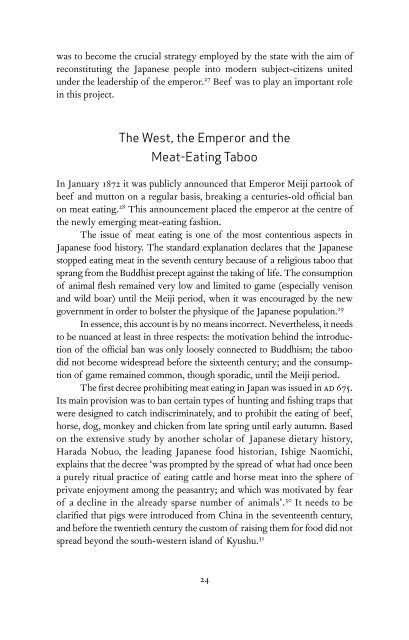Download - Brainshare Public Online Library
Download - Brainshare Public Online Library
Download - Brainshare Public Online Library
Create successful ePaper yourself
Turn your PDF publications into a flip-book with our unique Google optimized e-Paper software.
was to become the crucial strategy employed by the state with the aim of<br />
reconstituting the Japanese people into modern subject-citizens united<br />
under the leadership of the emperor. 27 Beef was to play an important role<br />
in this project.<br />
The West, the Emperor and the<br />
Meat-Eating Taboo<br />
In January 1872 it was publicly announced that Emperor Meiji partook of<br />
beef and mutton on a regular basis, breaking a centuries-old official ban<br />
on meat eating. 28 This announcement placed the emperor at the centre of<br />
the newly emerging meat-eating fashion.<br />
The issue of meat eating is one of the most contentious aspects in<br />
Japanese food history. The standard explanation declares that the Japanese<br />
stopped eating meat in the seventh century because of a religious taboo that<br />
sprang from the Buddhist precept against the taking of life. The consumption<br />
of animal flesh remained very low and limited to game (especially venison<br />
and wild boar) until the Meiji period, when it was encouraged by the new<br />
government in order to bolster the physique of the Japanese population. 29<br />
In essence, this account is by no means incorrect. Nevertheless, it needs<br />
to be nuanced at least in three respects: the motivation behind the introduction<br />
of the official ban was only loosely connected to Buddhism; the taboo<br />
did not become widespread before the sixteenth century; and the consumption<br />
of game remained common, though sporadic, until the Meiji period.<br />
The first decree prohibiting meat eating in Japan was issued in ad 675.<br />
Its main provision was to ban certain types of hunting and fishing traps that<br />
were designed to catch indiscriminately, and to prohibit the eating of beef,<br />
horse, dog, monkey and chicken from late spring until early autumn. Based<br />
on the extensive study by another scholar of Japanese dietary history,<br />
Harada Nobuo, the leading Japanese food historian, Ishige Naomichi,<br />
explains that the decree ‘was prompted by the spread of what had once been<br />
a purely ritual practice of eating cattle and horse meat into the sphere of<br />
private enjoyment among the peasantry; and which was motivated by fear<br />
of a decline in the already sparse number of animals’. 30 It needs to be<br />
clarified that pigs were introduced from China in the seventeenth century,<br />
and before the twentieth century the custom of raising them for food did not<br />
spread beyond the south-western island of Kyushu. 31<br />
24







